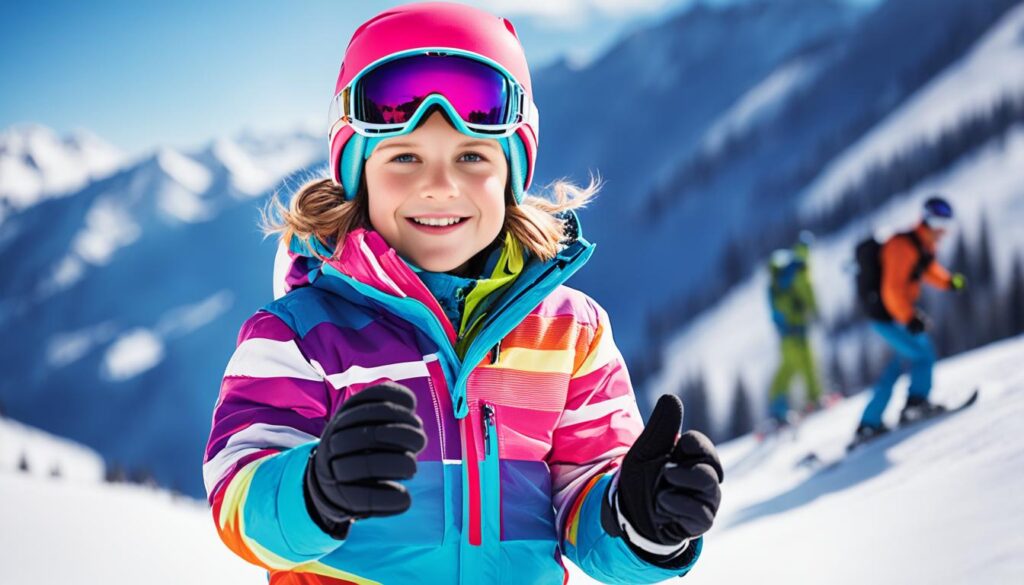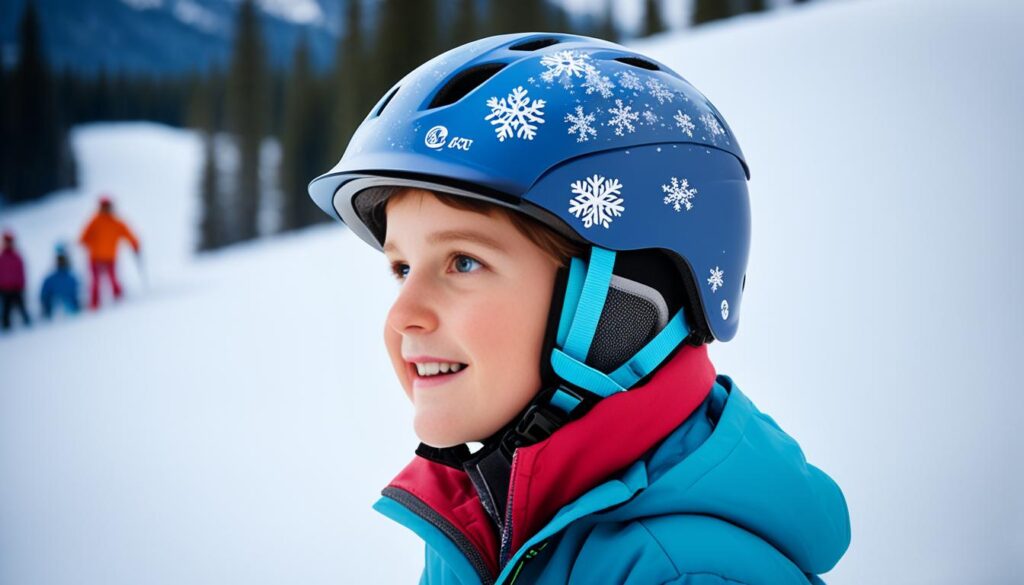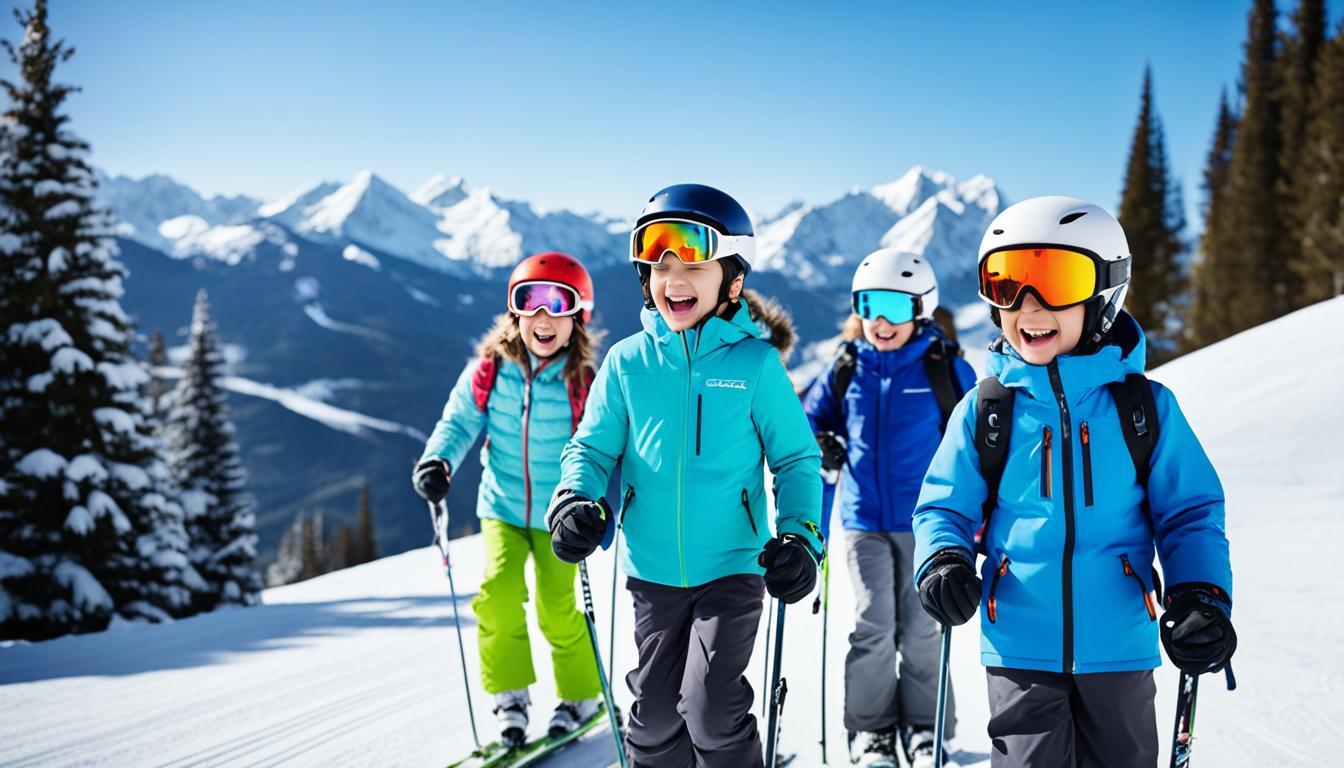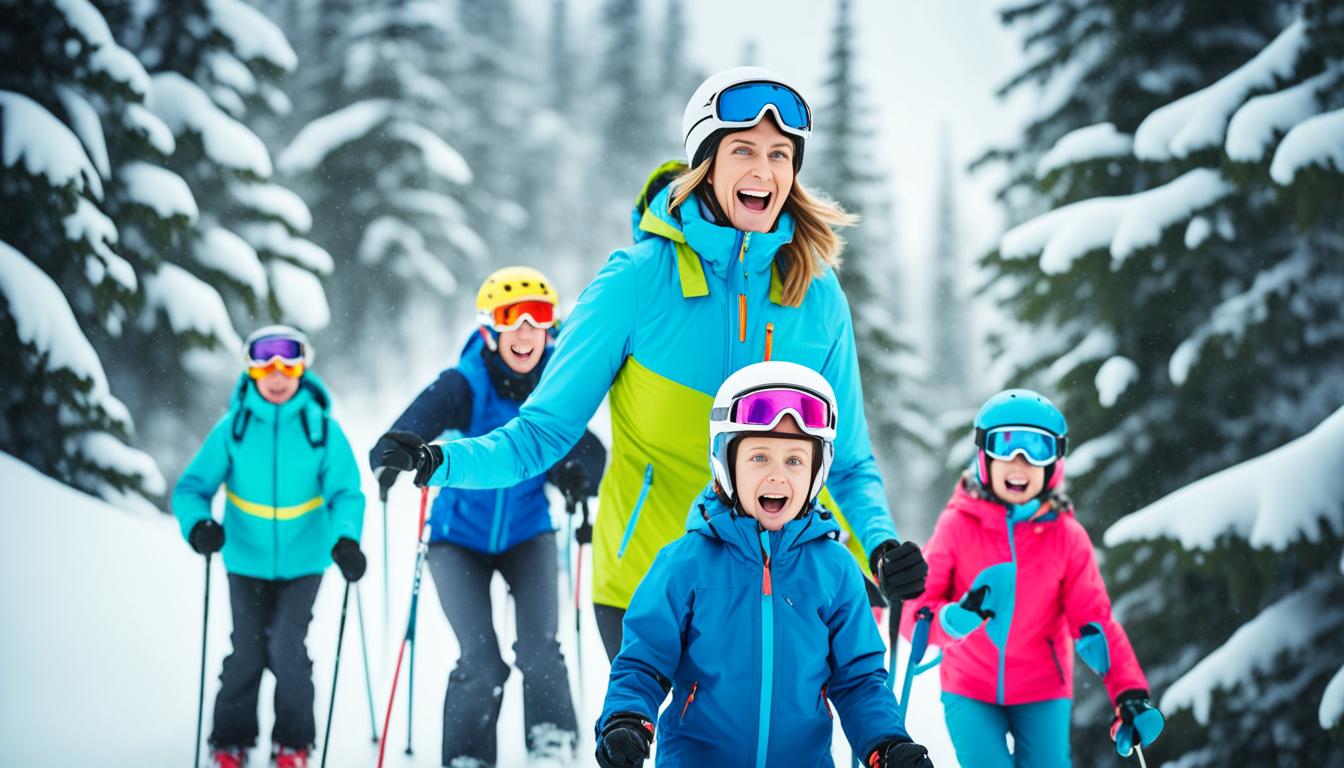When it comes to a family ski trip, our priority is always to keep our kids warm and happy on the slopes. We know that children are more sensitive to cold temperatures than adults, so it’s crucial to pack the right gear. To ensure your kids stay comfortable and protected during their winter adventures, follow these essential tips.
Key Takeaways:
- Invest in kids ski wear and winter clothing specifically designed for the slopes.
- Choose ski gear for children that includes ski jackets, ski pants, and cold weather accessories.
- Layer their clothing for warmth and consider packing a daypack for changing weather conditions.
- Protect their hands and feet with warm gloves or mittens and proper ski socks.
- Ensure their safety by providing goggles and a helmet that meets safety standards.
Dress Them in Proper Ski Gear
When it comes to enjoying a day on the slopes, dressing your kids in proper ski gear is essential for their comfort and safety. From ski/snowboard jackets to hats and goggles, investing in the right equipment will keep them warm and dry throughout their winter adventures.
Ski/Snowboard Jacket
A high-quality ski or snowboard jacket is a must-have for your child. Look for jackets that are designed to keep wind and snow out, with extra insulation for added warmth. Opt for waterproof and breathable materials to ensure your little one stays dry and comfortable.
Ski/Snowboard Pants
Choose ski or snowboard pants with a high waterproof rating to keep your child’s legs dry. Look for adjustable waistbands and reinforced knees for durability. Make sure the pants allow for a full range of motion to ensure your child can move freely on the slopes.
Mid-Layer
Layering is key to keeping your child warm in cold weather. Invest in a mid-layer jacket or fleece to provide extra insulation. This layer helps trap heat and can easily be removed or added as needed to regulate body temperature.
Gloves/Mitts
Protect your child’s hands with waterproof and insulated gloves or mittens. Mittens are often warmer and easier for younger children to put on. Look for gloves or mittens that cover the wrists to prevent cold air and snow from entering.
Goggles
Goggles are essential for protecting your child’s eyes from the sun and snow glare. Look for goggles with UV protection and anti-fog lenses. Ensure they have a proper fit and a secure strap to keep them in place during active play.
Thermals
Layering starts with a good set of thermals. Choose thermals made from moisture-wicking and insulating materials to keep your child warm and dry. Look for tops and bottoms that fit snugly but allow for ease of movement.
Socks
Keep your child’s feet warm and comfortable with ski socks. Look for socks that are specifically designed for skiing or snowboarding, with moisture-wicking and cushioning properties. Properly fitting socks will prevent blisters and ensure a comfortable fit in ski/snowboard boots.
Hats
A hat is essential for preventing heat loss through the head. Choose a hat that covers the ears and is made from a warm and breathable material. Look for hats with a snug fit that can be worn comfortably under a helmet.
Sun Cream
Even on cloudy days, the sun’s rays can be harsh on the slopes. Protect your child’s skin from UV damage by applying sun cream to exposed areas. Look for a broad-spectrum sunscreen with a high SPF rating and reapply regularly throughout the day.
Snow Boots
While ski/snowboard boots are essential for on-slope activities, don’t forget to pack a pair of snow boots for off-slope adventures. Look for boots that are waterproof, insulated, and have a sturdy sole for traction in snowy conditions.
Helmet
Ensure your child’s safety by always wearing a helmet when skiing or snowboarding. Look for a helmet that meets safety standards and has a chin guard for extra protection. Proper fit is crucial, so measure your child’s head and choose a helmet that fits snugly without being too tight.
Skis
Choosing the right skis for your child is important for their performance and safety on the slopes. Consult with a professional or an experienced salesperson to determine the appropriate size and type of skis for your child’s age, height, and ability level.
Ski/Snowboard Boots
Properly fitting ski/snowboard boots are essential for comfortable and controlled skiing or snowboarding. Visit a specialty shop to have your child’s feet properly measured and to find boots that provide the right combination of comfort and performance.
Complete Table of Ski Gear
| Item | Description |
|---|---|
| Ski/Snowboard Jacket | Provides wind and snow protection with added insulation for warmth. |
| Ski/Snowboard Pants | Waterproof pants with adjustable waistbands and reinforced knees. |
| Mid-Layer | Jacket or fleece for extra insulation and layering. |
| Gloves/Mitts | Waterproof and insulated gloves or mittens to keep hands warm. |
| Goggles | Protects eyes from sun and snow glare. |
| Thermals | Moisture-wicking and insulating base layer for warmth. |
| Socks | Specifically designed ski socks for comfort and moisture control. |
| Hats | Warm and breathable hats to prevent heat loss. |
| Sun Cream | Broad-spectrum sunscreen for UV protection. |
| Snow Boots | Waterproof and insulated boots for off-slope activities. |
| Helmet | Protective headgear for safety. |
| Skis | Properly sized skis for performance and control. |
| Ski/Snowboard Boots | Comfortable and properly fitting boots for skiing or snowboarding. |
Layer Up for Warmth
When it comes to keeping your kids warm on the slopes, layering is key. Not only does layering provide extra insulation, but it also allows for easy adjustments to their clothing throughout the day as weather conditions change. Make sure to follow these tips to help your kids stay cozy and comfortable while enjoying their winter adventures.
Choose the Right Insulation
Start by providing your kids with a fleece or insulated jacket. These jackets are designed to trap heat and keep them warm even in cold temperatures. Look for jackets that are lightweight and breathable, allowing for easy movement on the slopes. Additionally, choose a jacket that can easily be packed into a daypack for convenient carrying and storage.
Layering for Optimal Warmth
Layering is all about creating multiple barriers against the cold. Start with a base layer of moisture-wicking thermals to keep their body dry and warm. Next, add a mid-layer jacket or fleece for extra insulation. Finally, top it off with the fleece or insulated jacket mentioned earlier. This layering technique helps to trap heat and creates a warm, cozy environment for your kids to enjoy their time on the slopes.
“Layering is all about creating multiple barriers against the cold.”
Consider Your Child’s Comfort
It’s important to consider your child’s comfort when layering their clothing. Opt for materials that are soft, lightweight, and non-restrictive. Avoid bulky layers that may hinder their movement or cause discomfort. With the right combination of layers, your kids will be able to move freely while staying warm and comfortable.

Don’t Forget the Daypack
A daypack is a must-have accessory for any skiing adventure. It not only allows your kids to carry their essentials such as snacks, water, and extra layers but also provides them with a convenient place to store their fleece or insulated jacket when the weather gets warmer. Choose a daypack with adjustable straps and ample storage capacity to accommodate all their gear.
Investing in the right layering pieces and providing a daypack for easy storage will ensure that your kids stay warm and comfortable throughout their skiing experience. With these tips, you can enjoy a day on the slopes without worrying about the chilly temperatures.
Protect Their Hands and Feet
When it comes to keeping our little ones warm on the slopes, protecting their hands and feet is paramount. Cold temperatures can quickly cause discomfort and spoil the fun, so investing in the right gear is crucial.
Gloves and Mittens: Hands are known to get cold first, so a pair of warm and waterproof gloves or mittens is a must. Look for options that cover the wrists for added protection. Mittens are often a better choice for smaller children, as they offer more warmth and are easier to put on. With the right gloves or mittens, your child’s hands will stay cozy and comfortable throughout their skiing adventure.
Sock Liners and Ski Socks: Feet also need extra warmth and insulation in cold weather. Consider using sock liners, which are thin liners worn under ski socks to provide an additional layer of warmth. These liners help wick away moisture and can enhance insulation. Pair them with proper ski socks designed for cold conditions, and your child’s feet will stay toasty and comfortable all day long.
| Gloves/Mittens | Sock Liners | Ski Socks |
|---|---|---|
| Warm and waterproof | Thin liners for added warmth | Designed for cold conditions |
| Cover wrists for extra protection | Help wick away moisture | Enhance insulation |
| Mittens for easier wear (especially for smaller children) |
By prioritizing the protection of their hands and feet with gloves, mittens, sock liners, and ski socks, you can ensure that your child stays warm and comfortable while enjoying their skiing experience.
Safety First
When it comes to skiing, safety should always be a top priority for both children and adults. Ensuring that your child has the right equipment is crucial in keeping them safe on the slopes. In this section, we will discuss two essential safety gear items: goggles and helmets.
Goggles for Eye Protection
Goggles are an essential piece of gear for protecting your child’s eyes from the bright sunlight and snow glare. They provide clarity of vision and shield their eyes from potential hazards on the slopes. When choosing goggles for your child, make sure they have a proper fit and a secure strap to keep them in place during their ski adventures. Opt for goggles with anti-fog technology to prevent any visibility issues caused by condensation.
Helmets for Head Protection

Helmets are another vital safety item that children should wear while skiing. Many resorts have made it mandatory for kids to wear helmets to ensure their safety. Invest in a helmet that meets safety standards and provides adequate protection for your child’s head. Look for a helmet with a chin guard for extra coverage. It’s important for parents to set a good example by wearing their helmets as well, as children learn through imitation.
By equipping your child with goggles and helmets, you can provide them with the necessary protection to enjoy a safe and fun skiing experience. It’s crucial to choose gear that fits properly and meets safety standards for optimal performance.
Book Ski School and Take Breaks
When planning your family ski trip, don’t forget to book your child into a reputable ski school. Ski schools offer specialized instruction tailored to your child’s abilities, ensuring they learn proper techniques while having fun with other kids their age. It’s a great way for them to improve their skills and gain confidence on the slopes.
In addition to ski school, it’s important to take regular breaks throughout the day. Skiing can be physically demanding, especially for children who may not have the same stamina as adults. By taking breaks, you allow your child’s body to rest and prevent fatigue, reducing the risk of accidents or injuries.
Moreover, it’s essential to monitor your child’s adjustment to the altitude. Ski resorts are often located at high elevations, which can cause altitude sickness. Give your child time to acclimate and watch for symptoms such as headaches, dizziness, or shortness of breath. Make sure they stay hydrated and avoid overexertion.
“Taking breaks during skiing is crucial to prevent accidents and keep your child safe on the slopes.”
While out on the mountain, it’s vital to prioritize safety. Dress your child in bright and easily visible clothing, making it easier for others to spot them. Write your contact details on a piece of paper and place it in their pocket in case they get separated from you. Teach your child to avoid lifts or trails they’re not comfortable with, and never use leashes on-piste, as they can be dangerous.
Remember, the ultimate goal is for your child to have a fun and safe skiing experience. By enrolling them in ski school, taking breaks, monitoring altitude adjustment, and prioritizing safety, you can ensure that your family ski trip is a memorable and enjoyable one.
Conclusion
Skiing is a fantastic activity for families to enjoy together. By following these tips and keeping your child’s comfort and safety in mind, we can help them develop a love for skiing that will last a lifetime. Remember to prioritize fun over performance and create positive associations with the sport.
Enjoy your time together on the slopes and make lasting memories. Skiing not only offers physical activity and fresh mountain air but also provides an opportunity for families to bond and connect in a unique way.
So, gather your family, grab your skis, and get ready to hit the slopes. We hope these tips have stoked your enthusiasm for skiing and given you the confidence to plan an unforgettable family ski adventure. Embrace the joy of skiing as a family and create unforgettable moments that will be cherished for years to come.
FAQ
What kind of ski gear should I dress my kids in?
Dress your kids in proper ski gear, including a ski or snowboard jacket, ski or snowboard pants, mid-layer jacket or fleece, waterproof gloves or mittens, goggles, thermals, ski socks, a hat, sun cream, snow boots, a helmet, and properly sized skis and boots.
Why is layering important for keeping kids warm on the slopes?
Layering helps trap heat and allows for easy adjustments to their clothing to keep them comfortable throughout the day. It’s recommended to provide them with a fleece or insulated jacket that can easily be packed into a daypack for changing weather conditions.
How can I protect my child’s hands and feet from getting cold?
Invest in warm and waterproof gloves or mittens that cover the wrists. Mittens are often warmer and easier for smaller children to put on. Consider using sock liners and ski socks to provide extra warmth for cold days.
Are goggles and a helmet necessary for skiing?
Goggles are essential for protecting your child’s eyes from bright sunlight and snow glare. Ensure they have a proper fit and a secure strap. Many resorts require kids to wear helmets, so invest in a helmet that meets safety standards and has a chin guard for extra protection.
Should I book my child into ski school and take breaks?
Absolutely! Booking your child into ski school will provide them with specialized instruction and the opportunity to have fun with other kids their age. Taking breaks is important to prevent fatigue and ensure safety on the slopes.
How can I stay safe while skiing with my child?
To stay safe, dress your child in bright clothing, write your contact details and put it in their pocket, avoid lifts they’re not comfortable with, and don’t use leashes on-piste. Additionally, monitor your child’s adjustment to high altitudes and give them time to acclimate.
What’s the main takeaway from these tips?
By following these tips and prioritizing your child’s comfort and safety, you can help them develop a love for skiing that will last a lifetime. Remember to prioritize fun over performance and create positive associations with the sport. Enjoy your time together on the slopes and make lasting memories.




